The lifespan of your images on a microstock site, or more specifically the time for which they continue to sell is of great interest to the microstock photographer. With a relatively large investment in creating and uploading images, and with typical incomes in the first month being measured in dollars and perhaps tens of dollars you would hope that your images will continue to sell for quite some time enabling you to claw back your time investment and turn a profit.
This is not a new topic to the microstock world, it's already been well covered by Lee at microstockdiaries and his post on feeding the microstock beast. So as not to reinvent the wheel this post outlines only my view of the subject, some examples of my results, and is concluded by outlining how you can begin to measure your own results.

Images featuring IT equipment have a short shelf-life.
Sales tail off over time
When I started microstock in 2003 one of the most attractive things for me was that after all the 'hard work' was done each image was online and would be there selling 'forever', or at least that's what I thought... While certain images do age, there are plenty of 'timeless' stock images which if they age at all, do so a lot more slowly. Here's a graph of earnings from one of my early images, if you had asked me back in late 2008 I would have described as 'no longer sells'.
This image sold an average of 5 times per month between Sept 2003 and March 2006, the sales probably grew in line with the growth of istockphoto...
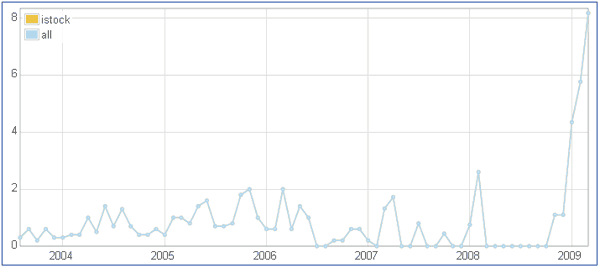
The same image that sold steadily over those previous years then sold zero times between March and October 2008. Since October last year it's started selling again. Noted these are the results of just one image on one site, and the graph is of earnings not downloads, hence it's been skewed as commission rates have increased. If we average the graph over 18 months then the recent crop of sales 20 sales still results in an overall downward trend in downloads compared with those made in 2004-2006. We can draw one conclusion, an image is not dead even if it's not sold in months.
Here are the earnings from another image, and while overall downloads are down, and the image is not a big seller, it has remained a consistent earner over the years, boosted by the increase of commission for each download. (In real terms that a loss against the cost of living.)
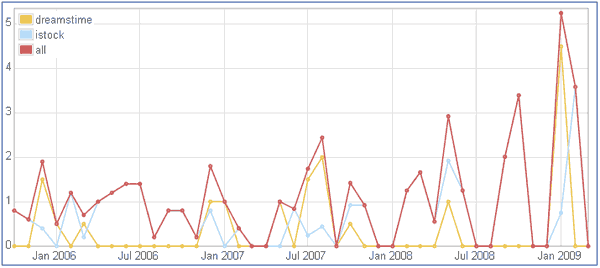
The times where I can see the most noticeable boom then bust in downloads are with my more recent images uploaded in the past year, and especially those accepted on shutterstock (an agency known for a strong bias towards recent images).
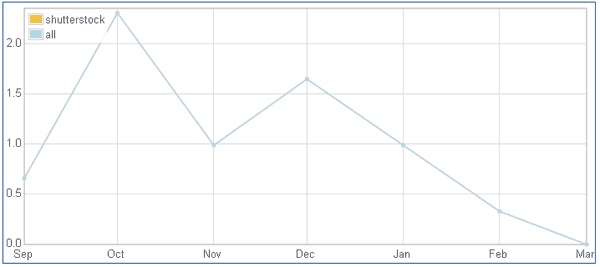
Looking at this graph reminds me of those stock market graphs which show a decline, but turn out to be just a blip when you look at the bigger picture, only by looking at this recent upload in a couple of years time will we be able to see the full picture.
If you were to only upload to a couple of sites and one of those was shutterstock then it's quite conceivable that if you stopped uploading your income could drop by up to 50%. I took a break from uploading between late November 08 and early March 09, Excluding shutterstock I didn't see anything like a 50% drop on my overall income.
As a rule of thumb microstock images have a half life of at least 2 years, but that statement is very much open to debate and very much dependent on the style and content of the image. Some images are more timeless than others.
Extended Licenses occur any time
From what I can see extended licenses are not affected by how generic or esoteric an image is, If you have a poor selling image that represents a popular search term and looks a lot like some other images that are available then it seems just as likely to generate and EL as something that's quite esoteric or specialist and is not selling much at all. Such Extended License sales can easily return your investment on a low earning image in a single sale.
Here are a couple of images that were quite happily drifting through life accruing one of two downloads a month, and then....
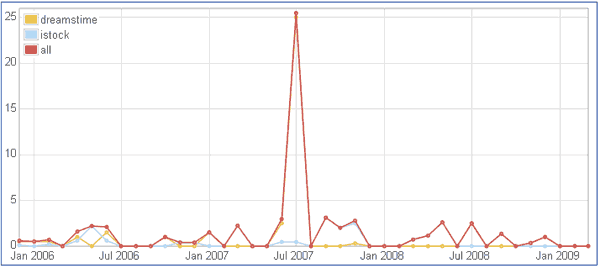
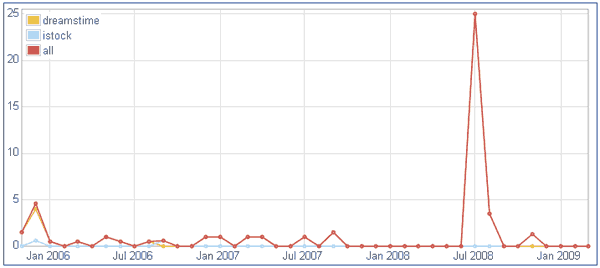
The various posts I have read about the microstock 'long tail' seem validated (larynandjanel, feeding the microstock beast). Having a portfolio full of 'unusual, one of a kind stuff', even if it only has limited applications, sooner or later will sell; and perhaps for a tidy premium. When combined these images will earn more overall than your most popular images. The $64,000 question is "which is more cost effective?", each of the log tail images has such a low RPI that the production costs become critical to making them cost effective when compared to a high selling single image.
Conclusions
My point of view, gathered from years of selling. I appreciate that the forums are full of people suggesting it's a good idea to cull old images from your portfolio, but for me that's not the way I see it:
- Concentrate on uploading new, good quality images.
- Don't feel obliged to contribute regularly, contribute when you can, or when you have something worth selling.
- If you stop uploading, income may reduce from some agencies (the initial boost that agencies give to new images) but most of your 'long tail' will continue to sell quite steadily.
- Don't remove old images that 'no longer sell' in a bid to get a better ranking
- Remember than an image with zero downloads over a couple of years can quite easily be the perfect image for someone who will fork out for an Extended License.
- We can reinforce that microstock is 'active income' and not a passive income stream, but if you stop uploading you can expect some level of income for several future years.
Related Posts:
How much can I earn from microstock
27 ways to unlock the power of microstock photography



It's quiet in here! Add new comment